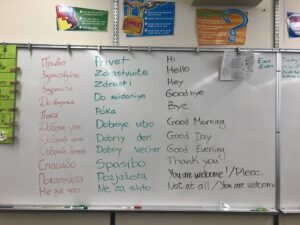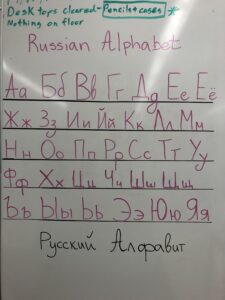I was eight years old when I started to learn English as a second language. I developed a substantial interest and connection with the English language. However, when I changed schools, I stopped trying, and my grades changed dramatically. My parents were very disappointed with me because I had stopped utilizing the skills in English I had gained and two because they had paid a lot of money to have me attend English speaking schools. When I saw the disappointment on my parents’ faces it influenced me to change my behaviour. I encouraged myself to learn English to the best of my ability and make my parents happy. In this paper, I will share my personal experiences with learning a second language, and I will provide tips for second language teaching from my perspective as a student. I find it essential for an educator to teach a second language to relate to the students when giving lessons. I will share some techniques that helped me as a second language learner and how educators should implement them when teaching.
When I started to learn English, I felt like I was staring at a blank page, everything just wasn’t making sense and I needed extra help. Students with low-level English may need extra help outside of class from their parents. My parents, unfortunately, don’t speak English so they, hired a tutor. Besides learning English in school, I was also doing extra work at home with my tutor. It was an excellent opportunity for me to receive valuable feedback. One on one learning encouraged me to work harder and always have my homework done. It was extremely hard for myself a struggling student to get that one-on-one time with my teacher who also had 24 other kids who needed her support and attention. Having a tutor helped my learning and took some of the burdens of my teacher as well. One on one learning can be possible in the classroom but usually based on the student and teacher coordinating a time outside of classroom hours.
The best way I found myself picking up on a second language was to be around English speaking people listening to their conversations with each other and picking up on keywords. As my English progressed I found myself wanting to be around people who spoke English more and have engaged in conversation with people who were fluent in English. There were times when I recognized myself keying in on words I had learned in class and a simple conversation felt like it equalled up to multiple classes or learning. Putting yourself into uncomfortable situations such as a conversation in another language with one or a group of people is scary but it’s also a necessary part of the learning process because it forces you to adapt and truly hone in on conversations enabling oneself to not only begin to understand what you’re hearing but at the same time utilize the material you’ve been taught in class. For a student who’s having difficulty speaking the language or a student who’s more introverted putting yourself in public situations or groups of people fluently speaking another language can be very off-putting and draining. Students who are having difficulty with a second language have other excellent options at their disposals such as practising sentence structure at home with online tutors or readily available apps on your smartphone to help decipher the language and better prepare students for the next days’ lesson. Having conversations with students helps the teacher assess each students’ cognitive level and determine which route would work best for each individual student so they stand the best chance to work and develop their skills. I was 9 years old when I went to England where I had no choice but to speak English. It is possible to do in the class, but it also depends on the students’ level of learning and dedication to mastering a second language, you don’t want to scare or discourage them. Teachers can choose one day to only speak in the second language. However, communication with the teacher will depend on the students’ level; they can either speak in English or their second language.
There are exciting ways to teach students how to speak in the second language; they include discussions, role play, simulations, information gaps, brainstorming, storytelling, interviews and reporting (Kayih, 2012). I always found role-play and storytelling the best, as it lets me be creative and be any character I wanted. Creativity is incredibly important for students of any age; as with creativity, students can break barriers and be more open to learning. Other options include creativity that doesn’t involve speaking or presenting to the whole class. Creative writing is a very effective way of teaching a second language. Students can write poems, postcards, and short stories. For some students, creative writing just like role-playing lets them be free in an environment they feel most comfortable, which also helps their learning. Techniques that are applied for Language Arts can also be used in second language learning because, in both ways, students learn and develop their language skills.
In my opinion, Canada is very well known around the world for its multiculturalism, and with thousands of students from around the world entering the Canadian school system, every school or classroom should have centers that can be used for Language Arts and second language. Those centers should be for reading, writing, listening, viewing, speaking and visual representation. Exactly like in English Language Arts, teachers can use the same stations for second language teaching, except for resources in the second language. It is a good idea to use resources that are already familiar, as they don’t stress students but help with their learning. I advise every classroom to have dictionaries available for students; by having access to a dictionary, students can look up new words without the teacher’s help. There were multiple times when I needed to look up a word in class and found it easier to resort to my dictionary instead of waiting to ask my teacher. Simply reading and writing can be challenging to capture students’ interest. However, without these two essential skills, students won’t be successful in learning any language. Manipulative-based teaching motivates students. Manipulatives capture students’ attention, which is an excellent opportunity for educators to teach the material. Teachers can use manipulatives when introducing new content and explain things that might be challenging for students to understand. Manipulatives are connected to imagination, and they let students be creative, just like in role-playing. Nash (2017) advises using StoryStarter developmental program created by LEGO Education to use in the classroom. The hands-on learning tools in this developmental program channel students’ creativity, critical thinking and relate their real-life experience to learning the second language. When students use StoryStarter, they engage in their learning (Nash, 2017). StoryStarter can be used for beginning and intermediate second language learners. Both levels of students can use it to plan stories, visualize material and enhance understanding. Examples of manipulatives to have in the classroom are toys, flashcards and familiar games such as puzzles. Corrales (2008) states that manipulation should be designed by teachers related to the curriculum standards and objectives. There must be meaning and reasoning behind manipulatives’ use, and they must connect with the content being taught. A teacher should be careful when introducing manipulatives, as they shouldn’t distract from learning; instead, they should encourage it. Manipulatives help students to comprehend and understand information better, as they are perfect for both kinesthetic and visual students (Corrales, 2008). However, manipulatives can be an advantage for both non-visual and kinesthetic learners. Manipulatives provide a hands-on way for students to interact with new information while creating understandings of work (Nash, 2017).
When teaching any language, no matter if it’s English or French, students must-read, after reading a text, it is better first to ask what the student understood about the reading, or what is interesting about it. Teachers and students can speak about the topic, which will give the student more information about the text relating speech to what was read. If necessary, teachers should explain fundamental concepts about the reading. Teachers can wait until students ask them the translation of words, or teachers can present the word to students. It can often be a good idea to begin by asking the student to guess what they think the word could mean. If the student is hesitant, the teacher can ask them to think about the context of the sentence or paragraph. Teachers must give their students the tools to figure out unknown words on their own; it is a game and part of learning which students and teachers should enjoy. Another option is to ignore the word completely, even if you suspect it is unknown to the student. We, as educators, must get used to the idea that when learning a new language, students will come across unfamiliar words often, and this should not scare them away from the reading. Something to always keep in mind and remember is for students, learning a lot of new vocabulary can be tedious and frustrating. Students do not enjoy classes filled with definitions, difficult new words and these regular explanations can distract from the text or the whole class. Educators should be careful when choosing reading material for students; they should check for difficulty level and relatable interests of the students in the class or age groups. I remember reading books that I didn’t enjoy, and they didn’t develop my grammar. It is imperative to select the correct material as it affects a student’s overall learning. Recognizing this when forming lesson plans is an excellent way for teachers to encourage students to be comfortable and help build their confidence when understanding and comprehending unfamiliar readings. Use summary exercises and simple leading questions. Consistently repeat back what the students say to you so that the students can hear what they said again. Constant repetition helps keep the class in a slower and simpler format, making it easier for the student to feel confident in their comprehension. It is an encouraging technique, especially for shy students, and motivates them to talk more because they can see that the teacher understands them. During the lesson, students should repeat what their teacher says to them as much as possible, even when the teacher doesn’t ask it. Teachers use this technique all the time and repeat student’s sentences with correct grammatical structure. This way, students will gain confidence in class and will be encouraged to talk more.
Teaching a second language is very much like teaching a first language. Nobody is born with the ability to speak, read and write; those are essential skills that are learnt. You must start from the beginning and slowly get to fluency. My path to learning English was long but very interesting and rewarding; I was fortunate enough to have opportunities to learn English in creative and exciting ways. As a teacher candidate, I believe in using personal experience in teaching and share it with my cohort. I find using creativity, manipulatives and visuals are essential to teaching any language. Language Arts centers can be effectively used not only in English but also in second language classes. A teacher should be supportive of students and encourage them to believe in themselves and don’t give up, because learning a new language is not easy for most people, but when hard work and dedication is applied the rewards are endless.


References
Hayriye Kayi, (2012) Teaching Speaking: Activities to Promote Speaking in a Second Language.
http://www.rusnauka.com/9_NND_2012/Pedagogica/2_104902.doc.htm
Kathleen Corrales, (2008). Getting your hands on learning: manipulative tools in content
ESL/EFL instruction. Latin American Journal of Content and Language Integrated Learning.http://citeseerx.ist.psu.edu/viewdoc/download?doi=10.1.1.1007.7839&rep=rep1&type=pdf
Jennifer Nash, (2017) Using Hands-On Manipulatives, Language Magazine.
https://www.languagemagazine.com/using-hands-on-manipulatives/